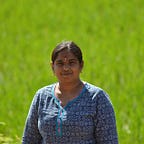Shaping Tomorrow’s Agriculture with Artificial Intelligence
Artificial Intelligence is becoming part of life day by day. It’s entering our homes and workspace at a faster pace. Recent advances in artificial intelligence and machine learning made life pretty simple.
AI made automation and optimisation possible in almost all the fields. AI is assisting farmers to improve their yield by utilising computer vision models. Agriculture machine help in improving the harvest of the farm.
So, how will a farm look like by 2030?
Farms would be completely on cloud connected to internet. Farmers manage farms from their office with their smartphones and systems. Sophisticated technologies like drones, robots, sensors and GPS are the future of agriculture technology.
Are we ready to meet the food needs of the growing population?
Agricultural machine paired with artificial intelligence helps to solve global food problems. These technologies enable farmers to improve the crop yields and optimise farmland.
The focus of the whole world is now on building technologies that help farmers double and triple their yield. Today’s farmer is ready for the transition, all he wants is a model or an agricultural machine that helps in farming.
Making computer vision models for farming needs the help of artificial intelligence and machine learning for training machine models. The performance of the agricultural machine depends on the data used for training the model.
Industrial drones, cameras fixed on farms observe the activities on the farm and take pictures and videos from time to time.
This data is used for training agriculture machines. To train models’ right annotation tool should be used for detecting objects. Each annotation tool has a unique usage.
Role of Box or rectangle annotation tool in building farming models/machines
Bounding Box or rectangle tool helps to annotate by drawing a box on the objects enabling the modelers/developers to train their computer vision models. This makes the machine understand the pattern and behaviour of the objects.
Drawing box around the row crops around the fields enables the you to train models to-
- Build algorithms for analyzing the yield of the crop.
By drawing a box over the row crops, agricultural machines can be trained to calculate the no of crops sowed per row. From this machine can estimate the total crops sowed in farm and analyze the yield.
- Detect crops which are not growing or producing.
Machines can be trained to identify crops that are not healthy or not growing as a normal crop.
- Manage multiple crops on farms or optimize land utilization for farming.
By annotating row crops in the farm using bound box tool helps the machine understand the dynamics of the farm. It provides data or suggests farmer regarding optimisation of land like space available for sowing multiple crops and suitable crops for sowing in that region.
Building tomorrow farming is possible with artificial intelligence. Companies around the world are now focusing on developing state of art computer vision models. Companies like OCLAVI helps you by providing a platform to annotate. OCLAVI enhances the model/machine quality even with low quality images.
Try OCLAVI
References:
